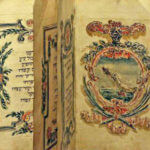By the time of the burning in Venice, Giustiniani, overwhelmed by the unbearable damage inflicted, had already ceased printing for over a year, and in 1553 Bragadin’s printing shop closed too.
Not until 1563 does the printing of Hebrew books in Venice resumed. In the meantime several smaller cities took advantage of the inactivity in the Serene Republic: Ferrara, Cremona, Mantua, and nearby Sabbioneta, where Cornelius Adelkind moved, and also Riva del Garda, where it was actually the bishop-prince, Cardinal Cristoforo Madruzzo, who supported the Hebrew printing house. But no publisher, despite their appreciable production, ever succeeded in equaling the quality achieved in the lagoon.
Starting in 1564 Pius IV allowed the printing of the Talmud, as long as it was censored and as long as the word “Talmud” did not appear on the frontispiece. The government of the Venetian Republic established strict controls on importing books, and an officer from the Holy Office of the Inquisition worked alongside the customs officials to check incoming shipments. The situation became even worse during the years of the Ottoman–Venetian War for Cyprus and the Battle of Lepanto (1571).
The return of peace and the reactivation of trade with the Ottomans restored an atmosphere of serenity to the lagoon, but the boom years were definitely a memory of the past: “At the end of the sixteenth century the Jews of Venice adopted a sort of self-censorship. Every volume had to contain the approval of the Rabbinate which attested to the absence of any kind of offense with respect to both Judaism and Catholicism.”
Jews will expurgate books according to our mandate,
and thus be allowed to use them.
Renato Maestro Library, photos by Mayank Austen Soofi
Things in Rome were changing. The Florentine Pope, Leo X, a member of the Medici family, son of Lorenzo the Magnificent, student of Poliziano, refined and cultivated humanist, protector of Michelangelo, Raffaello, Ariosto, and Machiavelli, with his thoroughly Renaissance interest in Jewish culture, died in 1521.
The Inquisition was now headed by the doctrinaire cardinal from southern Italy, Gian Pietro Carafa, who went on to sit on the papal throne with the name of Paul IV. He was a rigid and inflexible custodian of orthodoxy, imbued with hatred for the Jews, who made the struggle against heresy a life cause. In all likelihood, he saw the chance to intervene in the dispute between the two Venetian publishers as a golden opportunity.
Giustiniani and Bragadin did their best to provide Carafa with enough rope to hang them. According to Riccardo Calimani, “Each of the two printers, in his attempt to damage the other, claimed that the work of the other contained elements of blasphemy and propositions that were contrary to the Christian religion,” aided in this effort by the advice and council of converted Jews.
In August of 1553 Pope Julius III issued a bull ordering the seizure and burning of Hebrew books. The enforcers of the Inquisition entered the homes of the Jews, seized and threw into the street every printed item they could find.
The first burning of the Talmud and Hebrew books took place in Rome, in the Campo dei Fiori on September 9, 1553, the day of Rosh Hashanah. This time, Venice, which on other occasions had resisted the papal authorities to the point of being issued an interdict (the writ of excommunication for governments), gave in.
The Papal Nuncio, Ludovico Beccadelli, from Bologna, did everything he could to sustain the requests of the papal secretariat, and in October the Council of Ten ordered that indicted books be burned in Venice.
A month after the events in Campo dei Fiori, the fires burnt in the lagoon. The Nuncio himself communicated the news on October 21st, practically in real time: “Without prior notice they seized all of the remaining Talmuds of the gentleman’s edition, which were then publicly burned at the Rialto, and the copies belonging to Jews were set apart so that this morning another burning was held in St. Mark’s Square.”
The seventeenth century was a bleak period for several sectors of Venetian publishing, but the Hebrew sector is an exception.
It remained remarkably lively, thanks largely to Rabbi Leon Modena, perhaps the most prominent figure in the history of Venetian Judaism. The Haggadot (liturgical books for Passover) are not a Venetian invention, butin Venice that they reached the peak of their sophistication. In 1609 three copiously illustrated and linguistically important editions were published: “One for the Spanish rite with the first translation in Ladino in Hebrew characters; one for the German rite with the first translation in Yiddish; and finally one for the Italian rite with the first Italian translation in Hebrew characters.”
This last Haggadà is truly an original because it written in a vernacular Italian crammed with Venetian words, so that it could well be described as Venetian in Hebrew characters, a Venetian—Hebrew that will continue to be published throughout the century. The Haggadot printed in the Serenissima were the model for the Livorno Haggadà of 1892.
The 1640 edition—forty-eight pages and a hundred or so illustrations—has an introduction by Leon Modena, and the texts are at least partially attributable to him as well. He was also the author of the Historia de riti hebraici (History of Hebrew Rites), addressed first and foremost to gentiles, and of the Novo dittionario hebraico e italiano, meant primarily for Jews.
The genesis of Rabbi Modena’s dictionary is also interesting. He realized that translating the entire Bible from Hebrew into Italian would be an arduous and costly enterprise, it would have been difficult to obtain the authorization, and the Church would not look upon it kindly. At the same time, a working knowledge of Hebrew was becoming more and more limited to a small circle of scholars and therefore knowledge of the scriptures in Hebrew was gradually dying out. So the rabbi compiled a dictionary to make the Hebrew Bible more accessible to those whose knowledge of Hebrew is limited. The dictionary is printed in 1612 in an edition that today would be termed “mass market,” and reaches a sizable readership.
Alessandro Marzo Magno, Bound in Venice: The Serene Republic and the Dawn of the Book, 2013



